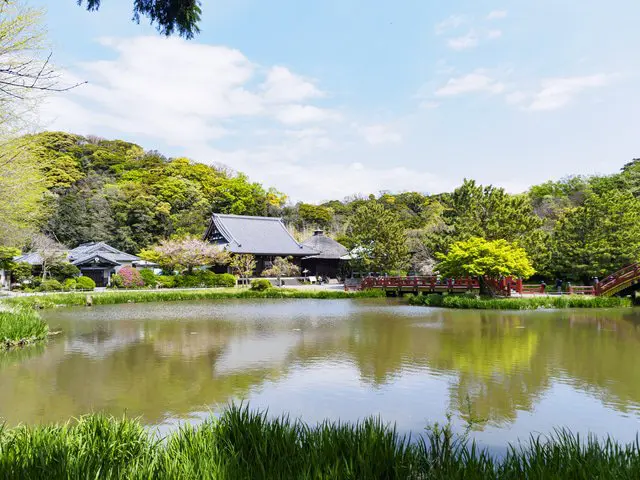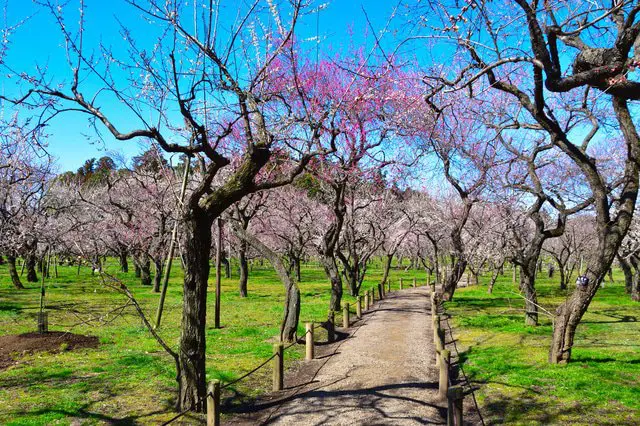Nihon Teien (Japanese Garden) - Japanese Encyclopedia

Trees and ponds shaped and surrounded by various types of seasonal plants and vegetation, or white sandy areas with stones of varying sizes and textures. In a Japanese garden, nature becomes a means of expression.
The Features of Japanese Gardens

Photo by pixta
Japan is a country full of natural wonders; in fact, it is believed that about 70% of the country by mountainous land.
A Japanese garden (’Nihon teien’) is a type of garden that is made using traditional techniques in order to recreate the natural landscape of this country. Gazing out at this miniature landscapes that change with the seasons is sure to make you feel a wide range of emotions, from serenity and relaxation to even an appreciation of the sometimes severity of the gardens.
Enjoying the Seasons Throughout a Garden that Mirrors Nature

Photo by pixta
A typical Japanese garden is based around an area of land with a number of uneven mounds, which represent hills or mountains. Stepping stones are then placed throughout it, along with trees and plants. These gardens are designed to be viewed all year long. There are a number of ways in which nature is represented in these gardens, such as by placing stones upright to mimic mountains, or creating the illusion of flowing water in dry gardens. Inside these gardens, Japanese-style lanterns, arbors, and tea rooms are also often added.
Representing the Magnificent Nature of Hills and Streams Without Water

In Japan, there’s a type of garden known as a karesansui, which is a style of Japanese garden that uses no water but only sand, stones, and trees to represent hills and water. Patterns that remind of flowing water are made by using white sand and small stones. The simplified view of nature that is condensed into the karesansui gardens has a deep connection with the principles of Zen Buddhism, so you will often find this style of gardens at Zen temples. Saihoji, Daitokuji, and Ryoanji in Kyoto are three famous temples where you can view karesansui gardens.
For more information on the karesansui, feel free to read this article: Karesansui Gardens - Japanese Encyclopedia
Three Famous Japanese Gardens

What type of Japanese garden should I visit first?
For those unsure of which Japanese garden to visit first, we will introduce the three most famous Japanese gardens. While visiting these three gardens, you will most surely understnad where the charm of Japanese gardens lies.
1. Kenrokuen (Ishikawa)

Photo by pixta
This is Kenrokuen, located in Kanazawa, Ishikawa prefecture. This garden is 11.7 hectares wide and is a special place of scenic beauty in Japan. The path around the pond here was built using what was the exterior of Kanazawa Castle, dating back to halfway through the 17th century. In the winter, there is a cone-shaped rope that stretches from the top to the bottom of the trees here in order for the branches not to snap under the weight of the snow. This rope is said to add poetic charm to the natural winter scenery of Kanazawa.
Address: Ishikawa, Kanazawa, Marunouchi 1-1
Official Site:http://www.pref.ishikawa.jp/siro-niwa/kenrokuen/e/index.html
2. Korakuen (Okayama)

Photo by pixta
Korakuen in Okayama city, Okayama prefecture, is another Japanese garden that features a path around a pond. However, this garden uses the surrounding landscape of Okayama Castle and the mountains to set off its beauty. In order for visitors to enjoy their time at this garden even more, it is built around the En'yotei, a building where you can relax.
Along with this building, there are a number of other places from which you can view this garden which also match perfectly with the environment. One spot of note is the vantage point from the building called Renchiken; the views from this building are superb.
Address: Okayama, Okayama, Kita, Korakuen 1-5
Official Site:http://okayama-korakuen.jp/english/
3. Kairakuen (Ibaraki)

Photo by pixta
Kairakuen is a Japanese garden in the city of Mito in Ibaraki prefecture that’s roughly 13 hectares wide. Believe it or not, this garden was first created back in 1842.
The name Kairakuen means ‘a garden where everyone can have fun’. Kairakuen was built for the feudal lord Tokugawa Nariaki, and was designed to be a place where "the people [of the region] could enjoy themselves together".
In the springtime, visitors can enjoy viewing the cherry blossoms, crimson red rhododendron flowers in early summer, and the vivid greens of the cedar trees and moso bamboo in the mid-to late summer. On top of that, you can view Japanese bush clovers and autumn foliage in the fall, and in late winter, you can enjoy their famous plum trees; there are 3000 trees composed of about 100 different varieties here.
Address: Ibaraki, Mito, Joban 1-3-3
Official Site: http://www.koen.pref.ibaraki.jp/foreign_language/en/index.html
Recently Very Popular - The Adachi Museum of Art

The Adachi Museum of Art in the city of Yasugi, Shimane prefecture, was opened in 1970 by Zenko Adachi, a businessman from the city of Yasugi.
The exhibitions here are centered around works by the modern Japanese artist Taikan Yokoyama, but this museum is also famously known for the vast Japanese garden that spans over 16 hectares.
Mr. Adachi believed that ‘this garden is another painting’; it is painstakingly maintained and cared for, and has been showcased a number of times by the media. With the number of visitors from both within Japan and around the world to this garden increasing, it is rapidly becoming a place that you simply must see while in Japan.
Address: Shimane, Yasugi, Furukawa 320
Official Site:https://www.adachi-museum.or.jp/ (Japanese)
When Visiting Japan, Enjoy the Moment in a Japanese Garden
On your trip to the land of the rising sun, by all means, enjoy a long stroll through a Japanese garden. Sit still and take a good look at a garden that utilizes the natural landscape in order to represent hills and streams without the use of water. Without a doubt, the experience of visiting an authentic Japanese garden will be one that you’ll never forget.
To those of you who’ve now gained an interest in Japanese gardens, we recommend reading this article as well: Five Must-See Gardens Recommended to Visitors
日本への訪日外国人の方が、もっと増えますように!





































![[Coupon Available] Attention Overseas Winter Sports Fans! Nagano's Sports Depot Has Evolved](https://resources.matcha-jp.com/resize/720x2000/2026/01/05-254819.webp)